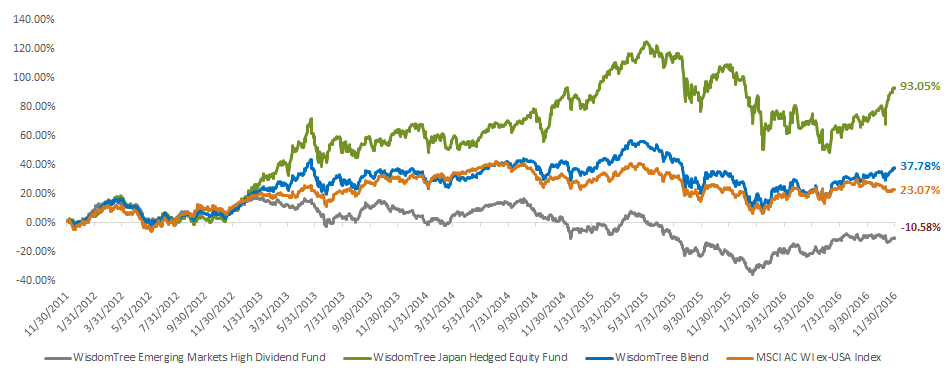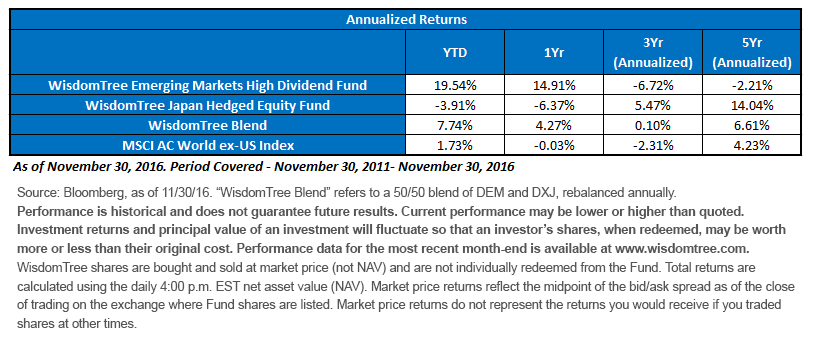How To Hedge Your Emerging Market Allocations Against A Strong Dollar
2016—until the election—had been the year of emerging market dominance. Commodities came roaring back, and not only was it the year of emerging markets (EM), it was also the year of emerging market currencies (with a weak U.S. dollar) and the commodity sectors within emerging markets. Countries such as Brazil, Russia and Peru led, while commodity importers like India and Korea lagged.
Since the election, however, there has been a new regime. The U.S. dollar started strengthening, and emerging markets faced a setback—although commodities have remained robust in the hope that infrastructure spending will support commodities and discussions of oil production cuts have supported oil.
Valuations Make EM Attractive, but What about Currency Risk?
One of the points supporting emerging markets is that anyone building capital market assumptions that incorporate a valuation factor in setting outlook will tend to be over-weight emerging markets. In the WisdomTree High Dividend Index family, for instance, the Emerging Markets High Dividend Index traded at a 50% price-to-earnings (P/E) discount to the High Dividend U.S. Index , one of the widest margins in last nine years. Of course, emerging markets entail higher risk levels, so they should trade at a discount, but I believe investing is about taking risks that you are compensated to take, so emerging markets look attractive to many.
But emerging markets are also critically reliant today on both China’s economy not meaningfully deteriorating and not suffering from too strong of a U.S. dollar. A strong dollar tends to reverberate throughout emerging markets, and that has been the environment over the last five years.
Blending Strong Dollar and Weak Dollar Beneficiaries to Diversify Factor Risk
One idea that could balance this currency risk is to combine a strong dollar beneficiary—a country that sees performance tend to increase on the back of a strong U.S. dollar—with emerging markets that are reliant on a weak U.S. dollar.
A blend I have talked about for this approach looks to DXJ, the WisdomTree Japan Hedged Equity Fund, which I believe is one of the exchange-traded funds (ETFs) most tied to a strong dollar and an improving U.S. economy, and DEM, the WisdomTree Emerging Markets High Dividend ETF, which is reliant on the opposite from a currency side—a weak U.S. dollar.
A 50/50 blend of these two funds makes an interesting comparison to the MSCI AC World ex-US Index over the last five years.
Over the past five years, emerging market currencies generally were under great pressure. Emerging markets and DEM underperformed the MSCI AC World ex-US Index considerably—by more than 5 percentage points per year over this period.
That was a time when Japan outperformed considerably. Over the full period, Japan on a currency-hedged basis outperformed the MSCI AC World ex-US Index by more than 10 percentage points per year.
Implementing a blend of these two exposures would have landed investors ahead over five years and also in 2016—a year emerging markets finally began turning around after a dismal five years
Allocating to a potentially strong dollar exposure—like DXJ, which is also among the lowest valuation countries in the developed world today—therefore has the potential to hedge what I think could be one of biggest risks to emerging market exposures for people who like the valuations presented therein.
The same can be said in reverse: If one is allocated to Japan exposure, perhaps a risk-mitigating strategy is also to allocate toward higher-dividend emerging markets that potentially benefit from a weak dollar and rising commodity prices.
In summary, this 50/50 blend not only has an attractive historical return profile. Looking at bottoms-up valuations of this 50/50 blend in comparison to the international benchmarks below, we believe this valuation profile could continue to look attractive going forward.
Cumulative Return Chart - WisdomTree Blend vs. MSCI ACWI ex-US Index
(Click on image to enlarge)
(Click on image to enlarge)
Click ticker for standardized performance of DEM and DXJ.
Fundamentals Perspective Supportive of WisdomTree 50/50 Blend:
Lower Price-to-Earnings Ratios, Higher Return on Assets (ROA) and Return on Equity (ROE)
(Click on image to enlarge)
Disclaimer: There are risks involved with investing, including possible loss of principal. Foreign investing involves currency, political and economic risk. Funds focusing on a single country, sector ...
more





